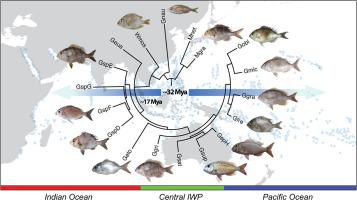Molecular Phylogenetics and Evolution ( IF 4.1 ) Pub Date : 2020-06-30 , DOI: 10.1016/j.ympev.2020.106902 Wei-Jen Chen , Philippe Borsa

|
The large-eye seabreams or Monotaxinae is one of two subfamilies in the Lethrinidae, a family of perch-like coral reef fishes. Despite its widespread occurrence and its commercial interest in the tropical Indo-West Pacific (IWP), this subfamily has traditionally been considered a taxonomically difficult group. Based on 268 samples collected from all 15 known large-eye seabream species throughout their distribution ranges, we investigated the taxonomic diversity and phylogenetic relationships in the subfamily. From the results of multiple analyses on four gene markers, we confirmed the monophyly of all four genera in the subfamily (Gnathodentex, Gymnocranius, Monotaxis and Wattsia). We confirmed the occurrence of two species in the genus Monotaxis. We reported 15 delimited species within the most speciose genus Gymnocranius, four of which are potentially new species. The time-calibrated phylogenetic reconstruction enabled us to clarify the evolutionary history of the large-eye seabreams and to infer past patterns of species distribution. The most recent common ancestor to the Monotaxinae likely occurred in the central IWP ca. 32 million years ago. A burst of species diversification likely took place during the Mid- to Late Miocene, coinciding with tectonic change in the central IWP region. This gave rise to most extant lineages in Gymnocranius. The observed geographic distribution patterns in the subfamily most likely point to the central IWP as the area of origin and diversification. This was followed by multiple events of centrifugal range expansion towards either the Indian Ocean or the western Pacific Ocean, or both. Our results thus provide new support for S. Ekman’s center-of-origin hypothesis.
中文翻译:

大眼鲷(Teleostei:Lethrinidae)的多样性,系统发育和历史生物地理。
大眼鲷或单栖类是鲈科(Lethrinidae)的两个亚科之一,该科是鲈鱼状的珊瑚礁鱼类。尽管它在热带印度洋-西太平洋(IWP)中广泛分布并且具有商业兴趣,但在传统上,该亚科被认为是分类学上困难的群体。基于在整个分布范围内从所有15种已知的大眼鲷物种中收集的268个样本,我们调查了该亚科的分类学多样性和系统发育关系。从对四个基因标记的多重分析结果,我们确认了亚科(Gnathodentex,Gymnocranius,Monotaxis和Wattsia)中所有四个属的单性。)。我们证实在Monotaxis属中出现了两个物种。我们报告了最特殊的裸藻属(Gymnocranius)中的15个定界物种,其中四个是潜在的新物种。经过时间校准的系统发育重建使我们能够阐明大眼鲷的进化史,并能够推断出过去物种分布的模式。单胞菌科的最新共同祖先可能发生在中部IWP左右。3200万年前。在中新世中期至中晚期可能发生了物种多样化的爆发,这与IWP中部地区的构造变化相吻合。这引起了Gymnocranius中大多数现存的血统。在亚科中观察到的地理分布模式最有可能指向中心的IWP作为起源和多样化的区域。随后是向印度洋或西太平洋或两者同时发生的离心范围扩大的多次事件。因此,我们的结果为S. Ekman的起源中心假说提供了新的支持。



























 京公网安备 11010802027423号
京公网安备 11010802027423号